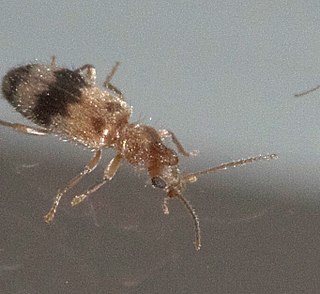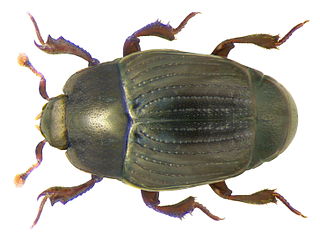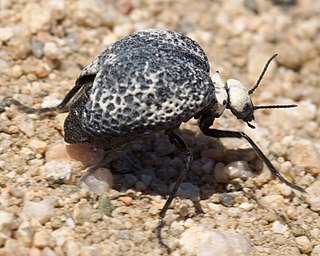
Zopherinae is a subfamily of beetles, commonly known as ironclad beetles. Together with the subfamily Usechinae, they have been treated historically as a family, but have recently been joined by several additional taxa, making the Zopheridae a much larger composite family, and the Zopherinae are now only a small component within it, consisting of seven genera in the tribe Zopherini and one, Phellopsis in its own tribe (Phellopsini).

Cicindela, commonly known as common tiger beetles, are generally brightly colored and metallic beetles, often with some sort of patterning of ivory or cream-colored markings. They are most abundant and diverse in habitats very often near bodies of water with sandy or occasionally clay soils; they can be found along rivers, sea and lake shores, sand dunes, around dry lakebeds, on clay banks, or woodland paths.

Eleodes is a genus of darkling beetles, in the family Tenebrionidae. They are endemic to western North America ranging from southern Canada to central Mexico with many species found along the Mexico-United States border. Some species have been introduced to Colombia. The name pinacate is Mexican Spanish, derived from the Nahuatl (Aztec) name for the insect, pinacatl, which translates as "black beetle".

Donacia is a large genus of aquatic leaf beetles in the subfamily Donaciinae. Like other members of that subfamily, the beetles have long antennae. They are active and able to fly. Larvae feed on submerged portions of aquatic plants, such as water lilies, and breathe oxygen from plant vessels. Adults live on surface parts of the same plants.

Notoxus is a large genus of beetles that resemble ants. It comprises about 300 species worldwide.

Anisodactylus is a genus of ground beetle native to the Palearctic, the Near East and North Africa.

Hydrochus is the only living genus of beetle in the family Hydrochidae, which belongs to the superfamily Hydrophiloidea, and was formerly treated as a subfamily of Hydrophilidae. Hydrochus includes about 180 species, which are found worldwide. The name "Hydrochus" has also been used for a fly genus in the family Dolichopodidae, but this is a junior subjective synonym of the genus Rhaphium.

Zopherus is a genus of beetles comprising 19 species. They live in the Americas and are adapted to wood-boring.

Diplocheila is a genus in the beetle family Carabidae. There are more than 30 described species in Diplocheila.

Trachyderini is a tribe of long-horned beetles in the family Cerambycidae. There are at least 140 genera and 650 described species in Trachyderini.

Crossidius is a genus of beetles in the family Cerambycidae.

Lytta is a genus of blister beetles in the family Meloidae. There are about 70 described species in North America, and over 100 species worldwide.

Asbolus verrucosus(LeConte, 1852), also known as the desert ironclad beetle or blue death feigning beetle, is a species of darkling beetle native to southwestern United States and northwestern Mexico, where it inhabits dry, sandy habitats such as the Sonoran and Mojave Deserts. It is highly adapted to hot environments and is omnivorous, consuming dead insects, fruits, lichen, and other plant matter. When threatened, the beetles are able to feign death. The species is becoming increasingly popular in the pet trade, due to their ease of care, hardiness, and longevity.

Nemadus is a genus of small carrion beetles in the family Leiodidae.

Geomysaprinus is a genus of clown beetles in the family Histeridae. There are at least 20 described species in Geomysaprinus.

Carcinops is a genus of clown beetles in the family Histeridae. There are at least 50 described species in Carcinops.
Xerosaprinus is a genus of clown beetles in the family Histeridae. There are more than 20 described species in Xerosaprinus.

Cysteodemus is a genus of desert spider beetles in the family Meloidae. There are at least two described species in Cysteodemus.
Euspilotus is a genus of clown beetles in the family Histeridae. There are more than 80 described species in Euspilotus.

















